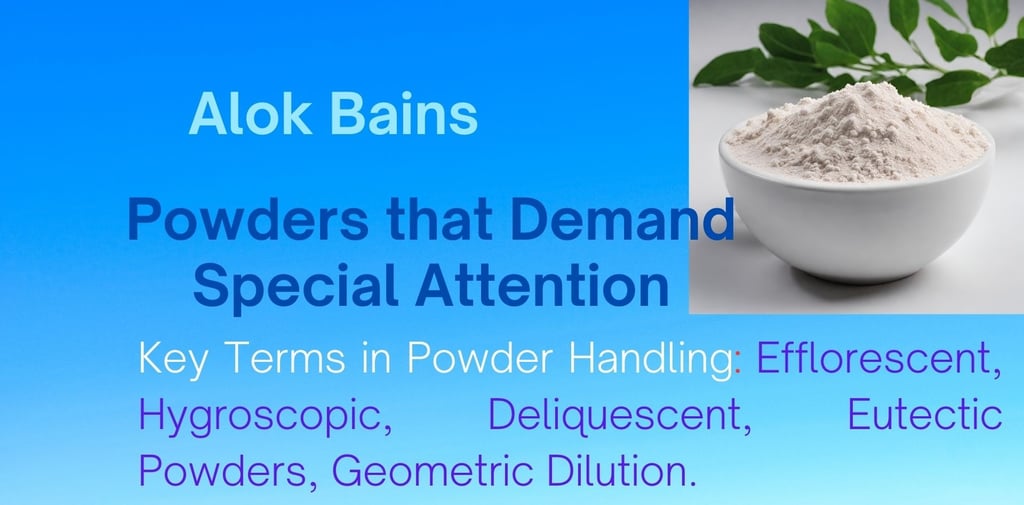Powder
Efflorescent powder, Hygroscopic powders, deliquescent powder, Potent powders Eutectic mixtures, Explosive substances, Potent drugs, Geometric dilution
CEUTICS I B.PHARM THEORY
Alok Bains
10/6/20233 min read


Types of Special Powder that require special consideration Continue.......
6. Efflorescent powder: Efflorescent powder contains a drug in crystalline form that liberates water of crystallization during triturating or during storage in low relative humidity. The release of water of crystallization converts powder into paste or liquid. Examples are sodium carbonate, caffeine, citric acid, cocaine, codeine, etc.
Precautions: Use of their anhydrous salt or mixing of anhydrous salt with efflorescent powder solves the efflorescence problem.
The following are the critical key points of efflorescent powders
a. Efflorescence: The process of loosening water from the crystalline structure during storage is called efflorescence. Evaporation of water forms visible crystals on the surface of the powder.
b. Pharmaceutical application: Efflorescent powders are used to control the release of active ingredients. Careful selection of ingredients in powder controls the drug dissolution and its absorption in the human body.
c. Dosage control: Efflorescent powder controls the release of drugs in a controlled and effective manner.
d. Moisture sensitivity: They are moisture sensitive. They need to be stored in air-tight containers under controlled humidity conditions.
7. Hygroscopic powders and deliquescent powder: A material that absorbs moisture from the atmosphere is called hygroscopic materials. A material that absorbs moisture from the atmosphere and liquefies is called deliquescent powder. Commonly used hygroscopic and deliquescent powders are ammonium chloride, ammonium bromide, ammonium iodize, ammonium citrate, calcium chloride, sodium iodide, sodium bromide, sodium chloride, sodium potassium citrate, phenobarbitone sodium, pepsin, citric acid, tartaric acid, etc.
Precautions: Pharmacists must take the following precautions to minimize water absorption problems.
i. Use the granular form of hygroscopic powder to reduce surface area. Their fine powder shall not be used.
ii. Assure double wrapping of powder. Pack it in aluminum foil or in a plastic film packet
iii. Store in a dry place.
iv. Use dry mortar to triturate them.
8. Eutectic mixtures: A mixture of two or more powders that liquefy after their mixing is called a eutectic mixture. The mixing of eutectic compounds forms a new compound. The new compound will have a melting point lower than room temperature. However, there will only be physical changes in the eutectic mixture no chemical changes. The degree of liquefaction depends upon room temperature, the melting point eutectic mixture proportion, and the relative proportion of eutectic mixture ingredients. The combination of any two following compounds liquefies upon mixing. They form an eutectic mixture. Aspirin, acetanilide, chloral hydrate, camphor, menthol, phenacitin, salol, thymol, etc.
They are dispensed separately to avoid their liquefaction with the direction to take both powders as a single dose. The addition of an inert absorbent in the eutectic mixture also solves the problem. Examples of such absorbents are bentonite, calcium phosphate, kaolin, magnesium carbonate, light magnesium oxide, lactose, starch, etc.
Each ingredient of the eutectic mixture is mixed with the absorbent separately. Then all are mixed together gently with the help of a spatula without applying pressure or friction
Rx
Menthol 5 gm
Camphor 5 gm
Ammonium chloride 30 gm
Light magnesium carbonate 60 gm
6. Explosive substances: Mixing of oxidizing agent and reducing agent may cause explosion. Precautions are taken in their compounding. Both oxidizing ingredients and reducing ingredients are mixed with other ingredients of powder separately. Then they are mixed cautiously. Alternately, both parts are dispensed separately with suitable directions to the patient. Examples of oxidizing agents are Silver nitrate, Potassium dichromate, Potassium chlorate, Potassium permanganate, Potassium nitrate, etc. Examples of reducing agents are Charcol, Sulphur, Sulphides, Tannic acid, etc.
7. Potent drugs: Substances with strong pharmacological effects at low doses are called potent drugs. Drugs with a dose less than one grain is called potent drug. A drug with a dose of less than 50 mg is considered a potent drug. Such a small amount should not be weighed on the dispensing balance. The potent powder is mixed with suitable diluents in definite proportion through the geometrical dilution method. Then they are packed in divided doses. Examples of potent drugs are prednisone, phenobarbitone sodium, etc.
8. Liquids: Sometimes liquid is added as an ingredient in powder dosage form. The liquid is triturated with an equal volume of powder. The rest of the powder is added in small proportions with continuous triturating. If the amount of liquid is large then absorbent is used as an ingredient.
Geometric Dilution: Geometric dilution is a technique to ensure uniform distribution of small quantities of drugs in large quantities of diluents. It is mainly used for the potent drugs. It is a process to make a homogeneous mixture of potent drugs and a large quantity of diluents. Potent drugs have lower doses. It requires to be mixed with a large amount of diluents. Potent drugs and approximately equal amounts of diluents are mixed in a mortar. The second portion of the diluents and an equal amount of powder mixture are again mixed inside the mortar. The process is continued till all the diluents are mixed with the potent drug and diluents mixture.
Alok Bains
